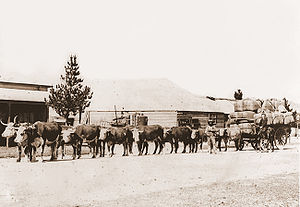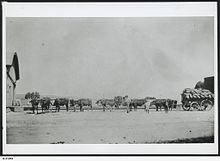169:
two heavy leather collars and a connecting chain. Thus connected they were turned out to graze and rest until they accepted the close presence of their partner. Untrained bullocks were then put in the centre of the team, where they were more easily controlled with the assistance and guidance of the "leaders" who were well trained to verbal commands. Pairs of bullocks were matched for size and yoked together using a wooden yoke secured to each bullock by a metal bow which was fixed in place by key on top of the yoke. Each pair was connected by a special chain, which ran from a central ring on each yoke to the next pair, thus coupling the team in tandem fashion. The "wheelers" or "polers" were the older, heavier, trained bullocks which were closest to the dray or jinker and helped to slow the load when necessary. Thus then was the team attached to the dray or jinker.
54:
46:
173:
driver; then by the use of all his strength he swung it over his head, often twirling it several times before he cracked it or let fall upon the back of a bullock he might wish to reach. Sometimes the bullocky had an "offsider" (a type of an apprentice) who walked on the offside (right) of the team and also assisted the bullocky yoke up and care for the team. Many
Australians who have never had contact with bullocky or a team still use the word "offsider’ as a synonym for an assistant, helper or learner.
157:
181:
490:
27:
38:
189:
of carrying large logs up to seven feet in diameter. The less common two wheeled jinkers bore and carried the front of log, leaving the end to trail along behind. Two jinkers could also be connected, with the back jinker linked by a log which would be chained to the front jinker. Jinkers were used in the transport of "Red Gold," Australian red cedar (
177:
jinker. The thong, often made of plaited greenhide, was 8 to 10 feet long and attached to the handle by a leather loop. These thongs, graduated in thickness from the handle down to the size of a lead pencil at the fall, which was about 2 ½ feet long. The bullockies often didn't use a cracker, but if they did it was knotted into the end of the fall.
188:
Bullock teams also dragged the heavy logs from some very steep, rough country to be loaded onto a jinker for hauling to a saw mill. Teams of up to thirty bullocks hauled large flat-top wagons or jinkers fitted with a single pole instead of shafts. Timber jinkers were of a four-wheel type were capable
172:
A bullocky walked on the nearside (left) of the bullocks for added control of the team and also because seating was not usually provided on the wagons and jinkers. The bullocky called each bullock by name to adjust its pace and effort. If the whip was needed it was flicked out in front of the bullock
168:
cattle because they were plentiful, hardy, tractable and readily matched up the team, which was often a source of pride to the owners. Teams had to be educated to perform their respective tasks, too. The first part of a bullock's education began when the bullocky tied two young bullocks together with
124:
Bullock drivers were typically skilled tough men who often faced extreme difficulties during their job. Bullockies were also colourful characters, often noted for their strong language. Some did not swear though, relying solely on gesture, talking and whip movements as persuasion for the team's job
198:
On steep hills bullock teams often required additional assistance to negotiate these inclines. This assistance was provided by hitching two or more teams together for the ascent. On steep descents logs or trees were dragged behind the dray, wagon or jinker to slow the load's descent and protect the
152:
were less excitable and more dependable when faced with difficulties than horses. Furthermore, bullocks were cheaper to purchase, equip and feed. Horses also required complex, expensive leather harness that frequently needed repair. Bullock gear was simple and the yokes were sometimes made by the
176:
A bullock whip had a stick handle that was cut from a spotted gum or another native tree and was approximately six or seven feet long. The long handled whip permitted the bullocky to control his bullocks while keeping a safe working distance from the danger of being run down by a large dray or
120:
and settlements far from regional transport hubs and urban centres. Some of the larger stations maintained their own teams for local use when harvesting and transporting wool. Both bullock and horse wagons carried heavy loads of wool and wheat which was the main produce transported over long
140:
During the early years the bullock tracks were very rough with narrow, steep "pinches", plus dangerous river and creek crossings. Many roads still follow the tracks made by bullock teams as they negotiated their way up or down hills via a winding course to make haulage easier.
235:(1886) has the following reference (page 137): "I knew a ‘bullockie’ (as these men are dubbed) who had a team of twelve beasts under his command which obeyed his every word and never received a word, which a ‘high-born ladie’ might not have listened to".
121:
distances, plus chaff and hay. A bullock wagon could only travel approximately three miles an hour (depending on the load and terrain) therefore it was slower than a horse team.
202:
Bullock teams were still used to drag logs from the forests to log dumps after the introduction of logging trucks. Nowadays they are mainly used for exhibition purposes.
108:
carried essential food and station supplies to isolated country areas. On return trips they transported wheat, wool, sugar cane, and timber by drays drawn by teams of
199:
team from injury. Shanties and villages grew to serve the needs of the road's users at the site of difficult range and river crossings where teams met.
134:
116:
or horses) to shipping ports before the advent of rail. They travelled constantly across the landscape, servicing the pastoral
510:
382:
89:
Bullock teams were in use in Sydney in 1795 when they were used for hauling building materials. The early explorers,
117:
520:
530:
494:
338:
Chisholm, Alec H. (ed.), The
Australian Encyclopaedia, Vol. 2, "Bullock-driving", Halstead Press, Sydney, 1963
525:
472:
281:
poem written anonymously under a pseudonym 'Bowyang York' in the late 1850s; the original inspiration for
90:
515:
53:
409:
245:
31:
160:
A bullock team hitched to two small jinkers (log conveyances) with a dolly in the foreground.
377:
Coupe, Sheena (ed.), Frontier
Country, Vol. 1, Weldon Russell Publishing, Willoughby, 1989,
406:
The
Australian National Dictionary: A Dictionary of Australianisms on Historical Principles
283:
249:
165:
20:
8:
126:
49:
A colour postcard printed of a team of 26 bullocks carting a large load of wool ca. 1909.
466:
66:
378:
212:
291:
45:
447:
422:
504:
256:
191:
94:
305:
271:
260:
109:
70:
295:, a 1969 Australian short documentary film by the Commonwealth Film Unit
393:
184:
A four-wheeled jinker with a bullock yoke and bows resting on the pole.
97:, later in 1828-9, also used bullock teams during their explorations.
267:
156:
137:
and carried a long bullock whip which in many instances he had made.
101:
315:
278:
195:), and other logs to sawmills or to a river for further transport.
130:
78:
180:
489:
238:
26:
427:
Braidwood
Dispatch and Mining Journal (NSW : 1888 – 1954)
310:
105:
37:
57:
A bullock team at
Farrell Flat, South Australia in 1911.
149:
113:
454:. Wagga Wagga, NSW (1911–1954). 1938-04-02. p. 3
351:p.22, The Horse Downunder Magazine P/L, Eagle Farm
224:are both of colonial growth, and so, I think, is…
502:
104:in Australia, in the mid 19th century, bullock
210:The following reference is from the newspaper
19:For the Australian Indigenous cricketer, see
239:Depictions in literature and popular culture
153:bullocky from different kinds of timber.
179:
155:
52:
44:
41:Yoking up the leaders of a bullock team.
36:
25:
373:
371:
144:
503:
364:. North Ryde: Macquarie Library. 1991.
77:. Bullock drivers were also known as
30:Bullock team hauling wool on a dray,
368:
334:
332:
330:
205:
129:hat, a twill shirt of that period,
125:at hand. A typical bullocky wore a
13:
354:
14:
542:
482:
347:The Horse Downunder, April 2009,
327:
488:
362:The Macquarie Dictionary, 2nd ed
440:
415:
398:
387:
341:
1:
321:
511:Animal husbandry occupations
216:of 17 July 1869 (page 17): "
7:
299:
10:
547:
84:
18:
69:term for the driver of a
471:: CS1 maint: location (
16:Driver of a bullock team
429:. 1939-10-27. p. 2
410:Oxford University Press
277:"Bill the Bullocky", a
246:Bill the Bullock Driver
233:‘New Chum’ in Australia
164:Bullockies often chose
32:Walcha, New South Wales
521:Livestock in Australia
185:
161:
58:
50:
42:
34:
531:Transport occupations
183:
159:
73:The American term is
56:
48:
40:
29:
526:Obsolete occupations
497:at Wikimedia Commons
404:Ramson, W.S. (ed.),
284:Dog on the Tuckerbox
145:Equipment and method
21:Bullocky (cricketer)
423:"BILL THE BULLOCKY"
186:
162:
67:Australian English
59:
51:
43:
35:
493:Media related to
538:
516:Australian slang
492:
477:
476:
470:
462:
460:
459:
452:Daily Advertiser
444:
438:
437:
435:
434:
419:
413:
402:
396:
391:
385:
375:
366:
365:
358:
352:
345:
339:
336:
213:The Australasian
206:Early references
546:
545:
541:
540:
539:
537:
536:
535:
501:
500:
485:
480:
464:
463:
457:
455:
446:
445:
441:
432:
430:
421:
420:
416:
412:, 1988, p. 105.
403:
399:
392:
388:
376:
369:
360:
359:
355:
346:
342:
337:
328:
324:
302:
241:
231:Percy Clarke's
228:(a teamster)".
208:
147:
110:draught animals
91:Hume and Hovell
87:
24:
17:
12:
11:
5:
544:
534:
533:
528:
523:
518:
513:
499:
498:
484:
483:External links
481:
479:
478:
439:
414:
397:
386:
367:
353:
340:
325:
323:
320:
319:
318:
313:
308:
301:
298:
297:
296:
288:
275:
264:
253:
240:
237:
207:
204:
146:
143:
86:
83:
15:
9:
6:
4:
3:
2:
543:
532:
529:
527:
524:
522:
519:
517:
514:
512:
509:
508:
506:
496:
495:Bullock teams
491:
487:
486:
474:
468:
453:
449:
443:
428:
424:
418:
411:
407:
401:
395:
390:
384:
383:1-875202-01-3
380:
374:
372:
363:
357:
350:
344:
335:
333:
331:
326:
317:
314:
312:
309:
307:
304:
303:
294:
293:
289:
286:
285:
280:
276:
273:
269:
265:
262:
258:
257:An Old Master
254:
251:
250:Henry Kendall
247:
243:
242:
236:
234:
229:
227:
223:
219:
215:
214:
203:
200:
196:
194:
193:
192:Toona ciliata
182:
178:
174:
170:
167:
158:
154:
151:
142:
138:
136:
135:blucher boots
132:
128:
122:
119:
115:
111:
107:
103:
98:
96:
95:Charles Sturt
92:
82:
81:or carriers.
80:
76:
72:
71:bullock team.
68:
64:
55:
47:
39:
33:
28:
22:
456:. Retrieved
451:
448:"Famous Dog"
442:
431:. Retrieved
426:
417:
405:
400:
394:Murphy Whips
389:
361:
356:
348:
343:
306:Bullock cart
290:
282:
274:(poem, 1889)
272:Henry Lawson
263:(poem, 1910)
261:C. J. Dennis
252:(poem, 1876)
232:
230:
225:
221:
217:
211:
209:
201:
197:
190:
187:
175:
171:
163:
148:
139:
127:cabbage tree
123:
99:
93:in 1824 and
88:
74:
62:
60:
102:gold rushes
100:Before the
75:bullwhacker
505:Categories
458:2019-08-30
433:2019-08-30
349:Timbertown
322:References
133:trousers,
467:cite news
268:The Teams
222:gumsucker
218:Cornstalk
79:teamsters
316:Ox-wagon
300:See also
292:Bullocky
279:doggerel
226:bullocky
150:Bullocks
131:moleskin
118:stations
114:bullocks
112:(either
63:bullocky
85:History
381:
65:is an
311:Oxbow
270:" by
259:" by
248:" by
166:Devon
106:drays
473:link
379:ISBN
220:and
507::
469:}}
465:{{
450:.
425:.
408:,
370:^
329:^
61:A
475:)
461:.
436:.
287:.
266:"
255:"
244:"
23:.
Text is available under the Creative Commons Attribution-ShareAlike License. Additional terms may apply.





